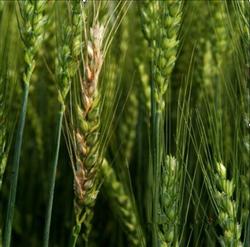asci Learn more about asci
-
How does the hippocampus reproduce?

Seahorses are the only animals on earth that produce offspring from males. Male hippocampus abdomen, front or lateral long have asci. During mating, females release eggs into the brood sac, and males fertilize these eggs. The male hippocampus keeps the fertilized egg
2020-11-11 Hippocampus how reproduce is on earth the only one by -
What effect does humidity have on wheat scab?

What effect does humidity have on wheat scab? Please introduce the effect of humidity on the occurrence of wheat scab is greater than the effect of temperature. Continuous high humidity for a long time is the primary condition for the disease. Asthecium can only be produced when the soil surface is wet. According to observation, when the relative humidity of the soil surface reaches more than 80%, the asci...
2018-07-19 -
Control of Infective Gummosis of Peach Tree

A disease caused by a fungus belonging to the subphylum Ascomycetes. It mainly damages the branches. When the disease occurs on the annual shoots, small protuberances are initially produced centered on the dermatome layer, and later tumor-like protuberances with a diameter of 1 - 4 mm are formed, which do not shed glue in that year. By early April of the following year, the tumor
2020-11-08 seed peach tree infection sex flow gum disease control is by asci -
Treatment of scab disease in peach trees

Peach scab, also known as scab, black mole disease, is a common disease of the fruit tree. After the disease, black spots will appear on the fruit and cracks will occur. What is the treatment of peach scab? First, peach tree scab treatment method if there are scab symptoms, use beautiful fruit
2020-11-08 Peach tree scab disease treatment peach tree also known as black -
bark rot of Korean pine

Pine bark rot disease is also called drooping branch disease, soft branch disease, dead branch disease, withered shoot disease, is a branch ulcer disease, mainly harmful to pine species. Symptoms: The disease harms the bark of the branches of young Korean pine trees, and can also occur at the base of the trunk when it is serious, causing canker disease. The pine needles above the infected parts turned yellow-green to greyish green, and gradually turned brown to reddish brown. The injured branches shrink and wrinkle due to water loss, and the needle drop marks are slightly enlarged. When the lateral branches are diseased, the lateral branches will droop downward. branchlet base diseased, then
2019-01-15 -
Incidence regularity and control of Sclerotinia sclerotiorum in soybean

Soybean Sclerotinia sclerotiorum is common in Heilongjiang Province. In 2001, the disease was more serious in Raohe County. The incidence of soybean continuous cropping land was 3%, 30%, and the incidence of individual plots of sunflower stubble reached 50%. The plots with serious disease even lost production. 1 cause of the disease 1.1 Climatic conditions in mid and late July
2020-11-08 Species soybean sclerotia disease regularity and control -
needle drop disease of Korean pine

Needle drop disease of Pinus koraiensis is a common disease worldwide. The disease can infect from young trees to big trees, causing early defoliation, affecting growth and causing the death of diseased plants. Symptoms: The disease usually affects 2-year-old needles, and some 1-year-old needles can also be affected. At the beginning of the disease, small yellow spots or segmental spots were produced on the infected needles, and the whole leaves turned yellow and fell off in late autumn. In the spring of the following year, large, black or gray, long oval or elliptical protruding grains appeared on the infected needles, with paint luster and a longitudinal crack in the center, which were asci disks of pathogenic fungi. Some diseased leaves
2019-01-15 -
Powdery mildew of Schisandra chinensis

1. Disease symptoms: powdery mildew harms the leaves, fruits and shoots of Schisandra chinensis, among which young leaves and young fruits suffer most seriously. It often causes dry leaves, withered shoots and shedding fruits. In the early stage of leaf damage, needle-like spots appeared on the back of the leaf, which was gradually covered with a layer of white powder and extended to the whole leaf in severe cases. The diseased leaves change from green to yellow, curl up, wither and fall off. The disease of young fruit begins near the ear axis, and when it is serious, it gradually extends outward to the whole ear; the diseased fruit wilts and falls off, and black and brown spots appear on the pedicel and new shoots. In the later stage of the disease
2019-01-16 -
Introduction to the symptoms and control methods of honeysuckle powdery mildew

Honeysuckle is a perennial rattan shrub of honeysuckle family. It can be used as medicine with buds or flowers to bloom. Leaves and branches can also be used as medicine, with the effect of heat-clearing and detoxification. Now it is planted in many cities and counties from the south to the north of our country. Powdery mildew is a common disease on honeysuckle, which occurs widely in various planting areas throughout the country, causing serious harm.
2018-08-31
